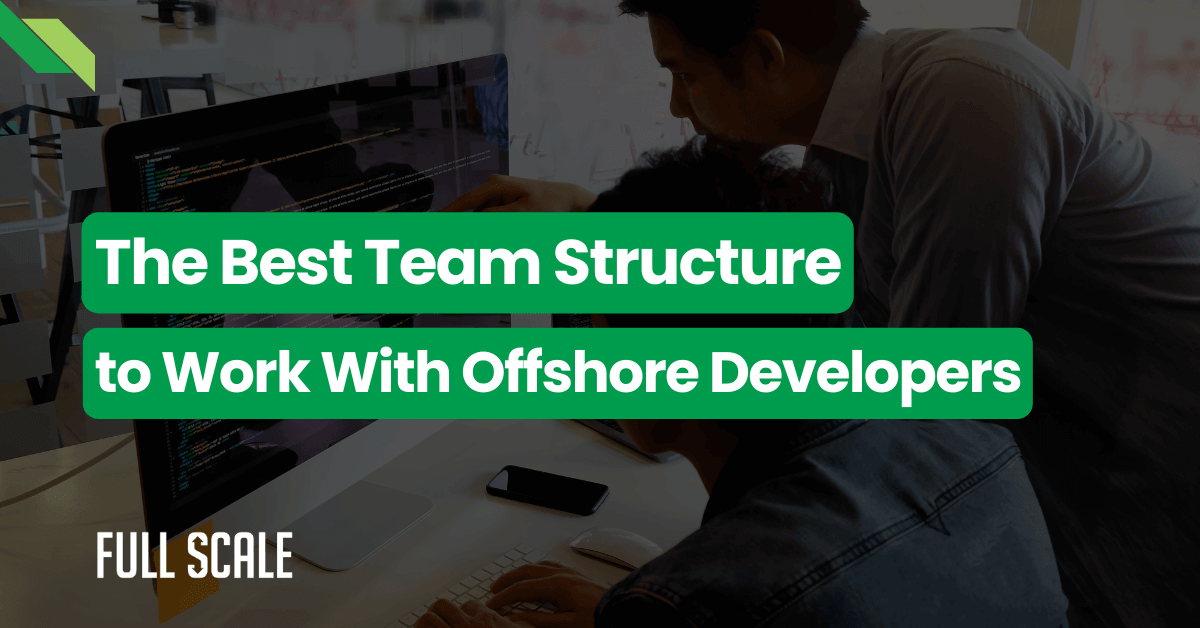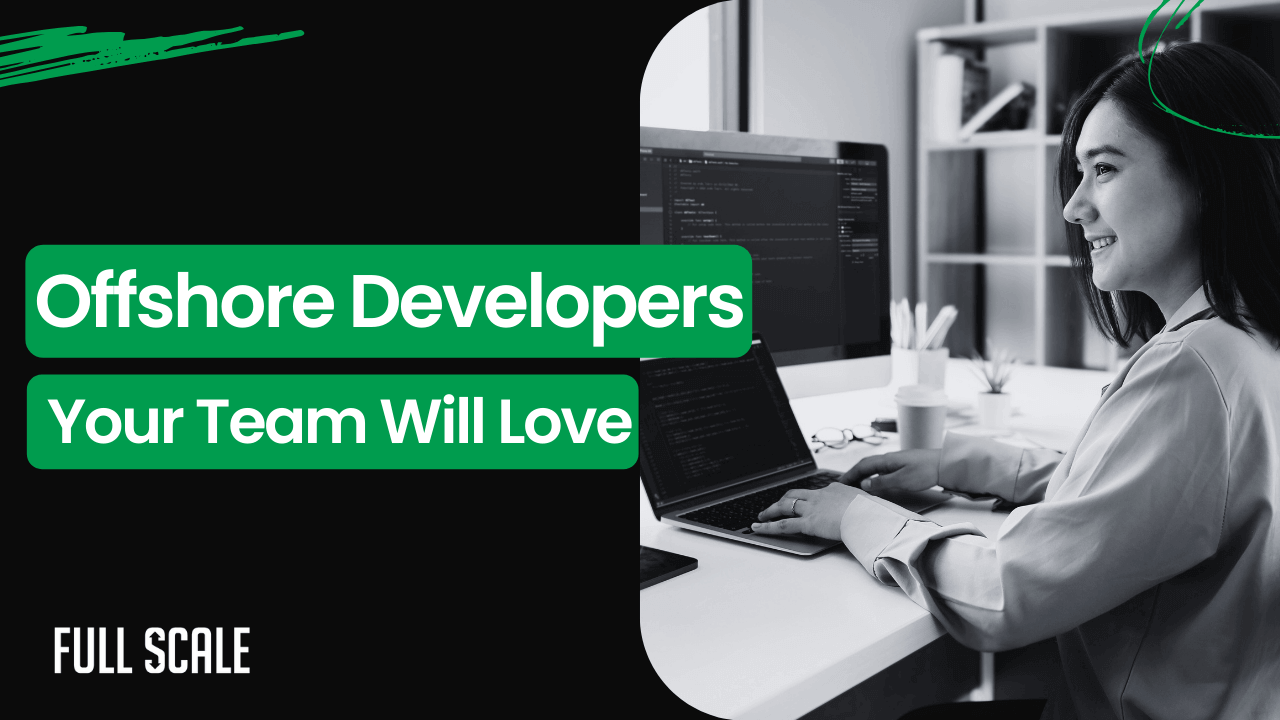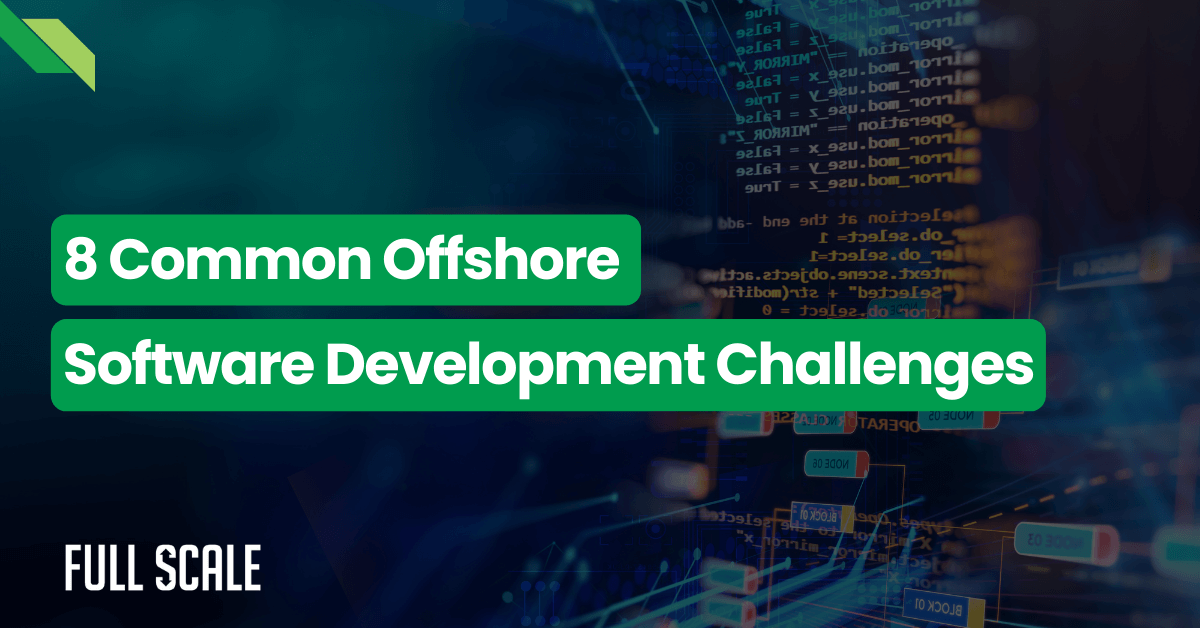Last Updated on 2025-07-02
Your last software project was supposed to take 3 months and cost $100K. Six months and $300K later, stakeholders still aren’t happy with what you built. Sound familiar?
This scenario plays out in 70% of software projects that fail due to poor requirements gathering.
Whether you’re scaling an in-house team or working with distributed developers, the cost of unclear software development requirements gathering compounds exponentially—especially when managing offshore development teams across different time zones and cultures.
What is Software Development Requirements Gathering?
Software development requirements gathering is the systematic process of identifying, documenting, and validating the functional and non-functional needs of a software system through stakeholder collaboration, analysis techniques, and documentation frameworks.
Requirement gathering in software engineering encompasses both the technical aspects of system design and the business context that drives feature development.
Software requirements gathering serves as the critical bridge between stakeholder needs and technical implementation, ensuring development teams build the right solution the first time.
This foundational phase involves collecting both functional requirements (what the system must do) and non-functional requirements (how well it must perform), ensuring all stakeholders align on project scope, timeline, and success criteria before development begins.
The Business Impact of Effective Requirements Gathering
Key statistics that every CTO and product leader should know:
- 70% of software project failures stem from poor requirements gathering (Standish Group)
- $62 billion is lost annually by companies due to inadequate requirements processes
- 40-50% reduction in development costs when requirements are properly gathered
- 189% average cost overrun in poorly planned projects
- Distributed teams are 3x more likely to fail without structured requirements processes
For technical leaders managing rapid growth, these numbers represent the difference between scaling successfully and burning through budget on projects that miss the mark.
Why Most Requirements Gathering Fails (And How to Fix It)
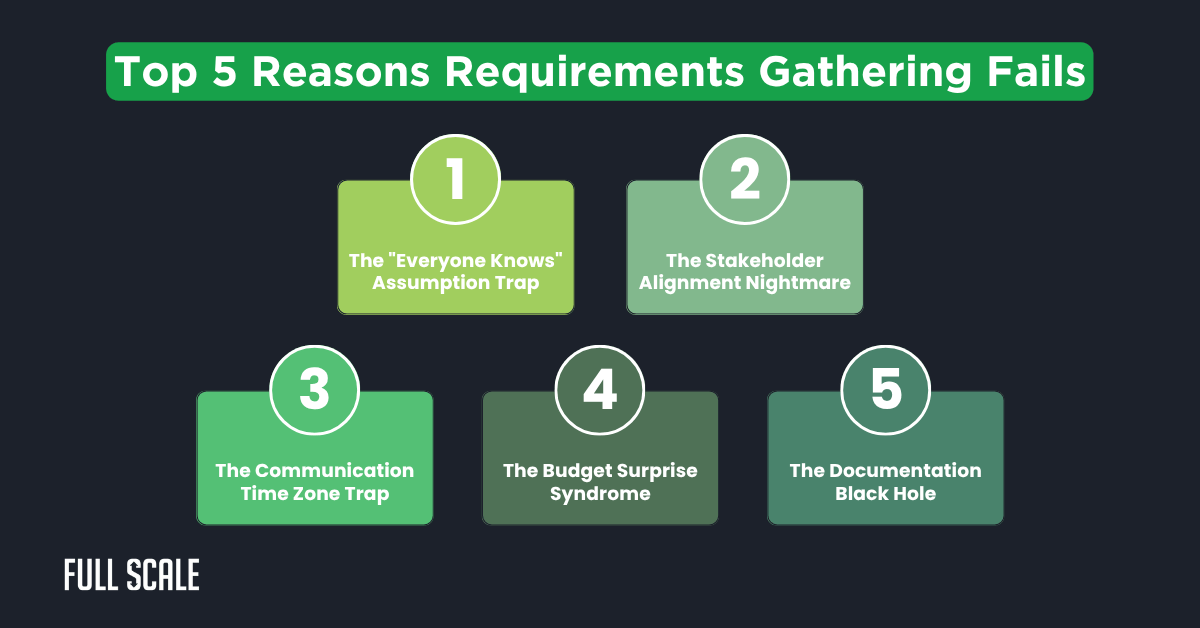
Okay, imagine this scenario: a fintech startup hired an offshore development team to build their trading platform. Three months in, the team delivered a system that processed trades perfectly.
But it couldn’t handle the regulatory reporting requirements that were ‘obviously’ needed. The project restarted from scratch, costing an additional $400K and 6 months of delays.
This failure illustrates how cultural and business context gaps amplify when working with distributed teams. Here are the top failure patterns and their solutions.
1. The “Everyone Knows” Assumption Trap
What Happens: Stakeholders assume certain requirements are “obvious,” leading to 60% of critical requirements never being documented.
Why It’s Worse for Distributed Teams: Cultural and business context differences mean your offshore team doesn’t inherently understand your industry’s unspoken rules, customer behavioral patterns, or internal processes.
The Fix: Implement explicit assumption documentation and cultural context sessions. Create “assumption logs” that capture what seems obvious to avoid dangerous gaps.
2. The Stakeholder Alignment Nightmare
Pain Point: “I’m constantly mediating between sales wanting features and engineering saying it’s impossible.”
What Happens: Different stakeholders want conflicting features, leading to 45% of projects changing scope mid-development.
The Fix: Establish a structured conflict resolution framework with clear decision hierarchies. Use RICE prioritization (Reach × Impact × Confidence ÷ Effort) to make data-driven decisions about competing requirements.
3. The Communication Time Zone Trap
Pain Point: “Our offshore team builds features perfectly—perfectly wrong.”
What Happens: Asynchronous communication leads to requirement misinterpretation, making distributed teams 3x more likely to build incorrect functionality.
The Fix: Implement synchronous requirement validation sessions with written confirmation loops. Establish daily overlap windows for complex requirement discussions.
4. The Budget Surprise Syndrome
Pain Point: “Every project I approve somehow costs triple the original estimate.”
What Happens: Poor requirements lead to massive scope creep, with an average 189% cost overrun in poorly scoped projects.
The Fix: Use requirements-based estimation with change control processes. Implement MVP definition and phased delivery approaches.
5. The Documentation Black Hole
Pain Point: “When Sarah left, we lost all context about why we built the user system that way.”
What Happens: Requirements exist only in people’s heads, leading to 70% knowledge loss when key team members leave.
The Fix: Establish structured documentation standards with knowledge transfer protocols that work across time zones and cultures.
The 5-Phase Requirements Gathering Process
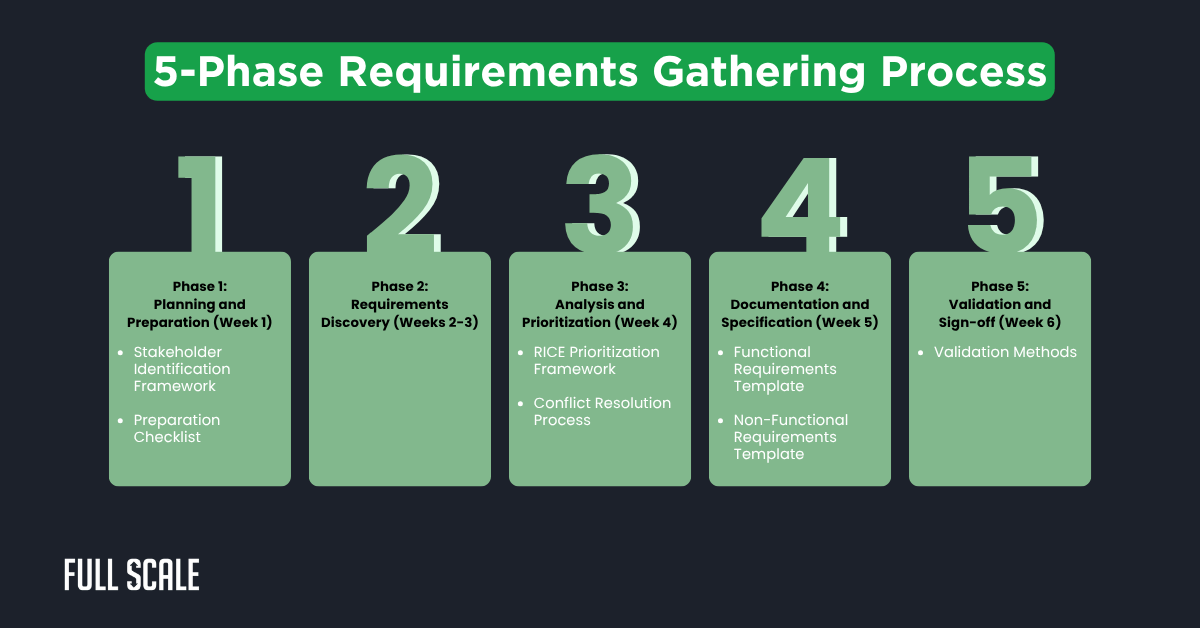
Successful requirements gathering follows a structured approach that transforms chaotic stakeholder needs into clear, actionable specifications.
This proven 5-phase methodology reduces project risk by 60% while ensuring all stakeholder groups remain aligned throughout the discovery process.
Phase 1: Planning and Preparation (Week 1)
Stakeholder Identification Framework
Primary Stakeholders:
├── Business Owners (Decision makers)
├── End Users (System operators)
├── Technical Team (Implementation)
└── Compliance/Security (Governance)
Secondary Stakeholders:
├── Customer Support
├── Sales/Marketing
├── External Partners
└── Maintenance Teams
Preparation Checklist
- Define project scope and boundaries
- Identify all stakeholder groups and their influence levels
- Schedule requirements gathering sessions across time zones
- Prepare documentation templates and collaboration tools
- Establish communication protocols for distributed teams
- Set up cultural context sharing sessions for offshore teams
Phase 2: Requirements Discovery (Weeks 2-3)
For Technical Stakeholders (CTOs, Engineering Managers)
- Architecture Decision Records (ADRs) workshops
- Technical constraint analysis sessions
- System integration mapping exercises
- Performance requirement modeling with real-world scenarios
For Business Stakeholders (Product Managers)
- User story mapping sessions with customer journey context
- Business process analysis and optimization opportunities
- Competitive feature analysis with market positioning
- Success metrics definition and measurement frameworks
For Financial Decision-Makers (CFOs)
- Cost-benefit analysis workshops
- ROI projection modeling with risk scenarios
- Resource optimization opportunity identification
- Budget allocation and timeline planning sessions
Phase 3: Analysis and Prioritization (Week 4)
RICE Prioritization Framework Example
Feature A: User Dashboard Redesign
Reach: 1000 users × Impact: 3 × Confidence: 0.8 ÷ Effort: 5 = 480
Feature B: API Performance Optimization
Reach: 500 users × Impact: 5 × Confidence: 0.9 ÷ Effort: 2 = 1125
Result: Feature B has higher priority due to better efficiency ratio
Conflict Resolution Process
- Identify conflicting requirements with stakeholder mapping
- Analyze business impact using quantitative metrics
- Conduct facilitated stakeholder negotiation sessions
- Document trade-off decisions with reasoning
- Obtain formal approval for compromises with sign-off tracking
Phase 4: Documentation and Specification (Week 5)
Functional Requirements Template
ID: FR-001
Title: User Authentication System
Description: The system shall authenticate users via email/password combination
Acceptance Criteria:
- User can log in with valid credentials in under 3 seconds
- System locks account after 3 failed attempts within 15 minutes
- Password reset functionality available via email verification
- Support for 2FA integration (future phase)
Priority: High
Dependencies: FR-002 (User Registration), NFR-001 (Security Standards)
Business Context: Required for regulatory compliance and user data protection
Non-Functional Requirements Template
ID: NFR-001
Category: Performance
Requirement: API Response Time
Specification: 95% of API calls must respond within 200ms under normal load
Measurement: Application Performance Monitoring with P95 metrics
Test Criteria: Load testing with 1000 concurrent users
Business Impact: Every 100ms delay reduces conversion by 7%
Phase 5: Validation and Sign-off (Week 6)
Validation Methods
- Requirements review sessions with each stakeholder group
- Interactive prototype validation against documented requirements
- Traceability matrix verification ensures complete coverage
- Impact analysis for any scope changes
- Formal approval process with documented stakeholder sign-offs
Top 5 Requirements Gathering Techniques for Distributed Teams
Traditional requirements gathering techniques often fail when applied to distributed teams across time zones and cultures.
These specialized requirements elicitation techniques account for communication delays, cultural differences, and the unique challenges of managing stakeholders who never meet face-to-face.
1. Structured Virtual Workshops
- Interactive requirements elicitation sessions are designed for distributed participation
- Time-boxed activities that maximize engagement across time zones
- Real-time collaborative documentation and validation
2. Asynchronous Requirements Collection
- Structured questionnaires and forms for comprehensive requirements capture
- Video requirement explanations to reduce miscommunication
- Cultural context documentation for offshore development teams
3. Visual Requirements Modeling
- User story mapping sessions using collaborative digital tools
- Process flow diagrams that transcend language barriers
- Interactive prototypes for requirements validation
4. Stakeholder Interview Frameworks
- One-on-one requirement elicitation interviews with structured agendas
- Cross-cultural communication protocols for offshore teams
- Requirements validation through multiple stakeholder perspectives
5. Documentation-Driven Requirements Analysis
- Comprehensive requirements documentation standards
- Requirements traceability matrices for complex projects
- Change management processes for evolving requirements
Advanced Techniques Selection Matrix
Requirements Gathering Tools Comparison
| Tool Category | Best For | Distributed Team Features | Cost |
| Collaboration | Real-time workshops | Multi-timezone support, recording | Miro ($8-16/user) |
| Documentation | Requirements management | Version control, templates | Confluence ($5-10/user) |
| Communication | Stakeholder alignment | Async messaging, video calls | Slack (Free-$12/user) |
| Prototyping | Requirements validation | Interactive mockups, feedback | Figma ($12-45/user) |
| Analytics | Requirements tracking | Metrics, reporting dashboards | Tableau ($70-150/user) |
Virtual Requirements Workshops for Global Teams
Face-to-face workshops are impossible when your team spans continents, but virtual sessions can be even more effective with proper structure.
These frameworks ensure productive collaboration despite time zone constraints and cultural barriers that typically derail remote requirements sessions.
Structure for Maximum Effectiveness
Pre-Workshop (1 week before)
- Send structured questionnaires via forms
- Share context documents and industry background
- Record video explanations of complex business processes
- Schedule individual stakeholder prep calls
During Workshop (2-3 hours, time zone optimized)
- Opening: Context alignment and agenda review (15 minutes)
- Main Session: Collaborative requirements mapping (90 minutes)
- Breakout Sessions: Detailed discussions by functional area (45 minutes)
- Closing: Summary and next steps confirmation (15 minutes)
- Real-time documentation sharing throughout
Post-Workshop (Same day)
- Send a written summary within 24 hours
- Distribute action items with owners and deadlines
- Share session recordings for future reference
- Schedule follow-up validation calls within 48 hours
Special Considerations for Offshore Development
Offshore development amplifies every requirements gathering challenge by adding cultural context gaps and communication delays. Understanding these unique dynamics is essential for preventing the costly misunderstandings that plague 70% of distributed development projects.
Why Distributed Teams Amplify Requirements Challenges
The Cultural Context Gap
When your development team operates in a different country and culture, they don’t inherently understand:
- Your industry’s regulatory landscape and compliance requirements
- Your customers’ behavioral patterns and usage expectations
- Your company’s internal processes and approval hierarchies
- The business context and competitive pressures behind feature requests
Time Zone Communication Complexity
- Requirements clarifications take 24-48 hours instead of 5 minutes
- Misunderstandings compound over multiple asynchronous exchanges
- Critical decisions get delayed waiting for stakeholder availability
- Documentation becomes the primary communication medium, requiring higher precision
Offshore Requirements Gathering Best Practices
Working with offshore teams requires enhanced documentation standards and cultural bridge-building that most organizations overlook.
These battle-tested practices eliminate the “lost in translation” problems that cause offshore projects to fail at 3x the rate of local development.
Quick Wins for Offshore Requirements Gathering
- Cultural Context Sessions – Invest 2 weeks in business context transfer
- Enhanced Documentation – Use visual specifications and assumption logs
- Daily Overlap Windows – Establish 30-minute sync sessions across time zones
- Validation Checkpoints – Implement weekly “understanding confirmation” sessions
Cultural Bridge Building Framework
Week 1: Business Context Immersion
├── Industry overview and competitive landscape deep-dive
├── Customer persona sessions with real user examples and data
├── Regulatory and compliance requirements with specific examples
└── Company culture and decision-making process explanation
Week 2: Technical Context Alignment
├── Existing system architecture walkthrough with live demos
├── Integration requirements and technical constraints documentation
├── Performance expectations with real-world usage pattern analysis
└── Security and compliance technical requirements with implementation examples
Enhanced Documentation Standards for Global Teams
Assumption Logs: Document what seems “obvious” to local teams
- Example: “US users expect credit card payments, but this market primarily uses bank transfers”
Cultural Context Notes: Explain business reasoning behind requirements
- Example: “This approval workflow exists because of SOX compliance, not inefficiency”
Visual Specifications: Use diagrams, mockups, and flowcharts to reduce language barriers
- Include annotated screenshots with explanatory callouts
- Create process flow diagrams with decision points clearly marked
Validation Checkpoints: Regular “does this make sense?” sessions
- Daily 30-minute overlap time for both teams
- Weekly demo sessions showing requirement interpretation
- Monthly cultural context Q&A sessions
Success Metrics for Distributed Requirements Gathering
Measuring requirements gathering effectiveness becomes critical when teams are distributed across time zones and cultures.
These specific metrics help identify process breakdowns before they become costly project failures, with particular focus on the unique challenges of offshore coordination.
Process Quality Indicators
- Requirements clarification cycle time (target: <24 hours)
- Assumption documentation completeness (target: 95% of “obvious” items logged)
- Stakeholder satisfaction with offshore team understanding (target: 8/10)
- Cultural context knowledge transfer effectiveness (measured via regular quizzes)
Outcome Quality Indicators
- First-time implementation accuracy (target: 90% of features built correctly)
- Post-delivery requirement change requests (target: <10% of original scope)
- Stakeholder satisfaction with final deliverables (target: 9/10)
- Development team confidence in requirement understanding (target: 8/10)
Stakeholder Management and Conflict Resolution
Managing stakeholders becomes exponentially more complex when team members span different time zones, cultures, and communication styles.
This framework provides structured approaches for maintaining alignment and resolving conflicts when traditional face-to-face methods aren’t possible.
Communication Strategies for Different Types of Leaders
For CTOs and VPs of Engineering
Communication Focus
- Technical feasibility analysis with architecture implications
- Resource requirements and realistic timeline assessments
- Risk assessment with technical debt considerations
- Integration complexity and system design impact
Preferred Formats
- Technical specification documents with architecture diagrams
- Risk-benefit analysis matrices with quantified trade-offs
- Resource allocation spreadsheets with skill-based planning
- Performance benchmarking with competitive analysis
Sample Communication: “The proposed microservices architecture will require 3 additional senior developers and extend timeline by 6 weeks, but will reduce future feature development time by 40% and improve system scalability to handle 10x user growth.”
For Head of Product Development
Communication Focus
- User experience impact and journey optimization
- Feature prioritization with market opportunity analysis
- Competitive positioning and differentiation opportunities
- Success metrics and measurable business outcomes
Preferred Formats
- User story maps with customer journey context
- Feature specification documents with acceptance criteria
- Interactive mockups and clickable prototypes
- Market analysis reports with feature gap identification
Sample Communication: “This user onboarding flow reduces time-to-value from 15 minutes to 3 minutes, matching best-in-class competitors and potentially improving trial-to-paid conversion by 25% based on industry benchmarks.”
For CFOs and Finance Directors
Communication Focus:
- ROI projections with sensitivity analysis
- Cost optimization opportunities and resource efficiency
- Risk mitigation strategies with financial impact
- Budget allocation recommendations with phased delivery options
Preferred Formats:
- Executive dashboards with key financial metrics
- Cost-benefit analysis with multiple scenario modeling
- Risk assessment matrices with probability and impact ratings
- Investment justification documents with payback calculations
Sample Communication: “The $150K investment in proper requirements gathering will prevent an estimated $600K in rework costs, delivering 4:1 ROI while reducing project risk from high to medium.”
Top 3 Advanced Conflict Resolution Framework
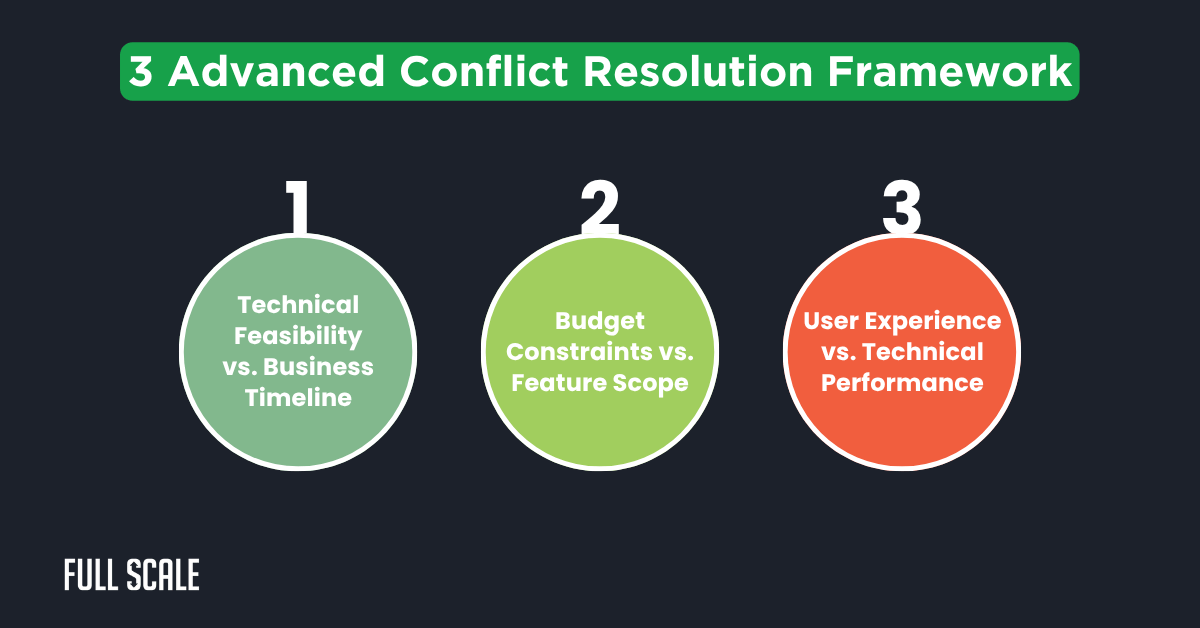
1. Technical Feasibility vs. Business Timeline
- Conflict: Engineering says feature needs 12 weeks, business needs it in 6
- Resolution Process: Technical spike with MVP definition
- Outcome: Phased delivery with core functionality in 6 weeks, advanced features in 12 weeks
2. Budget Constraints vs. Feature Scope
- Conflict: CFO approves $200K budget, full scope requires $350K
- Resolution Process: Value-based prioritization with ROI analysis
- Outcome: Phase 1 with highest-ROI features, Phase 2 conditional on Phase 1 success
3. User Experience vs. Technical Performance
- Conflict: UX wants rich animations, engineering warns of performance impact
- Resolution Process: Prototype testing with performance benchmarking
- Outcome: Selective animation implementation based on device capabilities
ROI and Business Impact Analysis
Investing in structured requirements gathering delivers measurable returns, but the benefits compound significantly for distributed teams where miscommunication costs more. These financial models demonstrate how proper requirements processes can deliver 783% ROI while reducing project risk.
Quantifiable Benefits of Structured Requirements Gathering
Organizations implementing structured requirements processes see dramatic improvements in delivery predictability and cost control. The benefits are most pronounced for distributed teams, where clear requirements can reduce development costs by 40-50% while improving quality outcomes.
Development Cost Savings
├── 40-50% reduction in rework and bug fixes
├── 30% faster development cycles through clarity
├── 25% reduction in testing overhead from clear acceptance criteria
└── 60% fewer post-launch critical defects requiring emergency fixes
Time-to-Market Improvements
├── 35% faster feature delivery through reduced back-and-forth
├── 50% reduction in requirement clarification delays
├── 40% improvement in development predictability and planning
└── 25% faster stakeholder approval cycles through structured processes
Investment Analysis: $500K Project Example
Requirements Gathering Investment Breakdown
├── Stakeholder Time (3%): $15,000
├── Requirements Management Tools (0.4%): $2,000
├── Documentation and Templates (1.6%): $8,000
├── Validation and Review Process (1%): $5,000
└── Total Investment: $30,000 (6% of project budget)
Expected Returns
├── Reduced Rework and Bug Fixes: $100,000
├── Faster Delivery (Time Value): $75,000
├── Improved Quality and User Satisfaction: $50,000
├── Reduced Maintenance Costs: $40,000
└── Total Return: $265,000
ROI Calculation: (265,000 – 30,000) ÷ 30,000 = 783% ROI
Long-term Strategic Benefits
Organizational Capability Building
- Enhanced stakeholder collaboration and communication
- Improved project predictability and risk management
- Better resource allocation and capacity planning
- Stronger client relationships through delivery excellence
Competitive Advantage Development
- Faster response to market opportunities
- Higher quality solutions with better user adoption
- More efficient development processes enabling cost leadership
- Enhanced reputation for delivery excellence
Implementation Framework
Transforming your requirements gathering process requires a structured rollout that accounts for team resistance and process maturity. This 3-month framework provides step-by-step guidance for implementing world-class requirements gathering across your entire organization.
Phase 1: Foundation Setup (Month 1)
Week 1-2: Infrastructure and Tool Selection
Requirements Management Tool Evaluation Criteria
- Integration with existing development tools (Jira, GitHub, etc.)
- Collaboration features for distributed teams
- Traceability and reporting capabilities
- Template and workflow customization options
- Cost and scalability considerations
Recommended Tool Stack
- Requirements Management: Confluence + Jira for integrated workflow
- Collaboration: Miro for visual workshops, Slack for communication
- Documentation: Notion for structured templates and knowledge base
- Video Communication: Zoom with recording capabilities for async review
Week 3-4: Pilot Project Execution
Pilot Project Selection Criteria
- Medium complexity (4-8 weeks development time)
- Engaged stakeholders willing to participate fully
- Clear business value with measurable outcomes
- Non-critical timeline allowing for process experimentation
Pilot Success Metrics
- Requirements clarity score (stakeholder survey)
- Time spent on clarifications vs. baseline
- Development team confidence in requirements
- Stakeholder satisfaction with the process
Phase 2: Process Optimization (Month 2)
Week 1-2: Data Analysis and Process Refinement
Key Metrics to Analyze
- Requirements gathering cycle time vs. baseline
- Number of requirement clarifications during development
- Scope change frequency and impact
- Stakeholder engagement and satisfaction scores
Process Optimization Areas
- Template improvements based on user feedback
- Workflow bottleneck identification and resolution
- Communication protocol refinement for time zones
- Documentation standards enhancement
Week 3-4: Team Training and Knowledge Transfer
For Technical Teams
- Requirements analysis and technical feasibility assessment
- Stakeholder communication for technical concepts
- Documentation standards and template usage
- Change management and scope control
For Business Teams
- Requirement articulation and acceptance criteria writing
- Technical constraint understanding and trade-off evaluation
- Stakeholder alignment and conflict resolution
- Process adherence and quality assurance
For Leadership Teams
- ROI measurement and process value demonstration
- Resource allocation and timeline planning
- Risk assessment and mitigation strategies
- Continuous improvement and optimization approaches
Phase 3: Organization-wide Implementation (Month 3)
Week 1-2: Scaled Rollout Strategy
Rollout Phases
Phase A: New projects starting this month (100% process adoption)
Phase B: Existing projects at requirements phase (adapted process)
Phase C: In-development projects (documentation catch-up)
Phase D: Maintenance projects (simplified process version)
Change Management Approach
- Champion identification in each team
- Regular feedback collection and rapid issue resolution
- Success story sharing and best practice dissemination
- Resistance identification and targeted support
Week 3-4: Continuous Improvement Establishment
Feedback Collection Mechanisms
- Monthly stakeholder satisfaction surveys
- Quarterly process effectiveness reviews
- Semi-annual ROI and business impact assessments
- Annual strategic process evolution planning
Continuous Improvement Process
- Monthly metric review and trend analysis
- Quarterly stakeholder feedback synthesis
- Process update implementation and communication
- Training material updates and team re-certification
Overcoming Common Implementation Challenges
Even the best requirements gathering processes face predictable obstacles during implementation, from stakeholder resistance to tool adoption challenges.
These proven solutions address the most common barriers that prevent organizations from achieving requirements gathering excellence.
Challenge 1: Stakeholder Time Availability
Symptoms
- Low attendance at requirements sessions
- Delayed responses to clarification requests
- Incomplete requirement reviews and feedback
Solutions
- Value Demonstration: Show ROI of participation with concrete examples
- Time Efficiency: Use structured agendas and time-boxed sessions
- Flexible Scheduling: Offer multiple time slots and async alternatives
- Executive Sponsorship: Secure leadership support for participation expectations
Implementation
- Create “Requirements Participation ROI” one-pager showing cost of delays
- Implement 25-minute focused sessions instead of hour-long meetings
- Provide pre-session materials and post-session summaries
- Have executives communicate participation importance and expectations
Challenge 2: Technical-Business Communication Gap
Symptoms
- Business stakeholders don’t understand technical constraints
- Technical teams miss business context and priorities
- Architecture decisions made without business input
Solutions
- Translation Workshops: Regular technical-business alignment sessions
- Visual Communication: Use diagrams, prototypes, and mockups extensively
- Cross-functional Pairing: Pair business and technical stakeholders for major decisions
- Business Context Documentation: Explain the “why” behind every requirement
Implementation
- Monthly “Tech Talk for Business” and “Business Context for Developers” sessions
- Create visual requirement specification templates with diagrams
- Establish business-technical buddy system for major features
- Include business impact statement in every technical requirement
Challenge 3: Distributed Team Coordination
Symptoms
- Requirements get lost in translation across time zones
- Cultural misunderstandings lead to incorrect implementations
- Async communication creates delays and confusion
Solutions
- Cultural Bridge Building: Invest in cultural context education
- Structured Communication: Use standardized formats and confirmation loops
- Time Zone Optimization: Find overlap windows and use async effectively
- Visual Documentation: Reduce language barriers with comprehensive visuals
Implementation
- Conduct cultural context workshops for offshore teams
- Create communication templates with confirmation requirements
- Establish daily 30-minute overlap sessions for complex discussions
- Use annotated mockups and process flow diagrams extensively
Measuring Success: KPIs and Metrics
Effective requirements gathering improvement requires specific metrics that track both process efficiency and business outcomes.
These measurement frameworks help organizations quantify their requirements gathering process maturity and identify areas for continuous improvement using a proven requirements gathering methodology.
Requirements Gathering Maturity Assessment
Level 1 – Basic (Ad-hoc Requirements Collection)
- No formal requirements gathering process
- Requirements exist primarily in emails and meeting notes
- High rate of scope changes and rework
Level 2 – Developing (Structured Approach)
- Basic requirements elicitation techniques in use
- Templates and documentation standards established
- Some stakeholder alignment processes
Level 3 – Advanced (Optimized Requirements Engineering)
- Comprehensive software requirements gathering methodology
- Integrated tools and automated workflows
- Strong stakeholder management and conflict resolution
Level 4 – Expert (Continuous Improvement)
- Requirements gathering best practices are consistently applied
- Advanced analytics and predictive capabilities
- Cross-project knowledge sharing and optimization
Process Efficiency Metrics
Understanding how efficiently your requirements gathering process operates requires tracking specific velocity and quality indicators.
These metrics reveal bottlenecks and improvement opportunities while providing benchmarks for comparing your performance against industry standards in software requirements gathering.
Requirements Gathering Velocity
- Time from project kickoff to requirements sign-off
- Number of stakeholder sessions required for consensus
- Requirements documentation completion time
- Stakeholder availability and engagement rates
Quality Indicators
- Requirements completeness scores (checklist-based assessment)
- Stakeholder satisfaction with requirement clarity (1-10 scale)
- Traceability coverage (% of requirements linked to business needs)
- Change request frequency during development
Communication Effectiveness
- Average time for requirement clarification resolution
- Number of misunderstood requirements discovered during development
- Stakeholder alignment scores on key decisions
- Cross-functional team collaboration ratings
Business Impact Metrics
The ultimate measure of requirements gathering success is business impact, from reduced development costs to improved stakeholder satisfaction.
These financial and operational metrics demonstrate the tangible value your improved requirements gathering methodology delivers to the organization.
Requirements Gathering ROI Calculator
Investment in Requirements Process: $X
Savings from Reduced Rework: $Y (typically 40-50% of development cost)
Time-to-Market Acceleration Value: $Z (typically 35% faster delivery)
Quality Improvement Value: $W (typically 70% fewer defects)
Total ROI = ((Y + Z + W) - X) / X × 100
Industry Average: 650-783% ROI
Financial Performance
- Project budget variance (actual vs. planned costs)
- Development cost per feature/story point
- ROI achievement vs. projected returns
- Maintenance and support cost trends
Delivery Performance
- On-time delivery rate for projects
- Scope change frequency and impact
- Feature adoption rates post-launch
- Customer satisfaction with delivered solutions
Organizational Benefits
- Team productivity improvements
- Stakeholder relationship quality scores
- Process adherence and adoption rates
- Knowledge retention and transfer effectiveness
Advanced Analytics and Reporting
Sophisticated requirements gathering programs require executive-level reporting that connects process improvements to business outcomes. These analytics frameworks provide the insights leadership needs to understand ROI and make informed decisions about process investments.
Executive Dashboard Components
- Project health scores based on the quality
- Resource utilization optimization through better planning
- Risk mitigation effectiveness measurements
- Competitive advantage indicators from faster delivery
Trend Analysis
- Requirements gathering maturity progression over time
- Cost savings accumulation and ROI trend analysis
- Team performance improvement trajectories
- Client satisfaction evolution with improved processes
When to Engage Requirements Gathering Experts
Many organizations struggle to implement effective requirements-gathering processes internally, particularly in complex distributed team environments.
Recognizing when professional expertise can accelerate your transformation helps avoid costly trial-and-error approaches while ensuring optimal results from day one.
Red Flags Indicating Professional Help is Needed
Project-Level Warning Signs
- Your offshore projects consistently deliver features that miss the mark
- Requirements gathering takes longer than actual development work
- Stakeholders are losing confidence in your distributed team approach
- You’re spending more time fixing misunderstandings than building features
Organizational-Level Warning Signs
- Multiple projects are experiencing similar requirement-related failures
- High turnover in product management or technical leadership roles
- Inability to accurately estimate project timelines and costs
- Client relationships are suffering due to delivery disappointments
Team-Level Warning Signs
- Your offshore team asks the same types of clarifying questions repeatedly
- Development teams express frustration with unclear or changing requirements
- Business stakeholders feel their needs aren’t being understood or met
- Requirements documentation exists, but doesn’t actually guide development
What Professional Requirements Gathering Provides
Structured Methodologies
- Proven frameworks adapted for distributed team success
- Industry-specific requirement elicitation techniques
- Stakeholder management and communication protocols
- Quality assurance and validation processes
Cultural Bridge Building
- Cross-cultural communication training and facilitation
- Business context transfer processes for offshore teams
- Cultural assumption identification and documentation
- International project coordination best practices
Implementation Support
- Tool selection and configuration for your specific needs
- Team training and change management support
- Process customization for your industry and organization
- Ongoing optimization and continuous improvement guidance
Risk Mitigation
- Requirement-related project risk identification and mitigation
- Change management processes that prevent scope creep
- Conflict resolution frameworks for stakeholder disagreements
- Quality gates and validation checkpoints ensure completeness
There Is An Efficient Way to Transform Your Development Process
Effective software requirements gathering is not just a project phase—it’s a strategic capability that separates high-performing development organizations from their competitors. The evidence is clear:
Organizations that invest in structured requirements processes achieve:
- 783% average ROI on their requirements gathering investment
- 40-50% reduction in development costs through improved clarity and reduced rework
- 35% faster time-to-market through eliminated back-and-forth and scope changes
- 70% fewer critical defects in production systems through comprehensive validation
For distributed and offshore development teams, the impact is even more pronounced:
- 3x improvement in first-time implementation accuracy
- 50% reduction in cross-cultural miscommunication issues
- 60% faster requirement clarification cycles through structured processes
- 90% increase in stakeholder confidence in distributed team capabilities
The Path Forward: Your Implementation Roadmap
Month 1: Foundation Building
- Assess your current requirements gathering maturity using the frameworks in this guide
- Select and implement appropriate tools for your distributed team structure
- Choose a pilot project and execute it using the 5-phase process
- Collect baseline metrics for future ROI measurement
Month 2: Process Optimization
- Analyze pilot results and refine processes based on learnings
- Train your team using the role-specific approaches outlined
- Expand implementation to 2-3 additional projects
- Establish feedback collection and continuous improvement mechanisms
Month 3: Organizational Transformation
- Roll out optimized processes across all new projects
- Implement measurement systems for ongoing process improvement
- Establish cultural bridge-building practices for offshore teams
- Create organizational capability for sustained competitive advantage
The Strategic Imperative
In today’s competitive software development landscape, requirements gathering excellence is not optional—it’s essential for survival and growth.
Organizations that master this capability gain:
- Predictable delivery that builds stakeholder confidence and enables accurate business planning
- Cost leadership through the elimination of expensive rework and scope changes
- Speed advantage through reduced clarification cycles and faster stakeholder alignment
- Quality differentiation through comprehensive validation and testing alignment
- Scalability foundation that enables confident team growth and global expansion
The investment in proper requirements gathering pays dividends throughout the entire software development lifecycle and creates a sustainable competitive advantage through faster delivery, higher quality, and superior stakeholder satisfaction..
Skip the Requirements Gathering Headaches – Let Full Scale Handle Everything
If you’re considering hiring software developers, don’t let requirements gathering become your biggest challenge.
At Full Scale, we’ve perfected the art of seamless requirements gathering for distributed teams, eliminating the costly miscommunications that plague 70% of offshore development projects.
Here’s what makes Full Scale different:
- Pre-Built Requirements Framework – Our developers come equipped with proven methodologies that prevent the “lost in translation” problems common with traditional offshore teams
- Cultural Bridge Specialists – We assign dedicated requirement analysts who understand both your business context and technical implementation, ensuring nothing gets lost between stakeholders and developers
- Same-Day Clarification Guarantee – No more 24-48 hour delays waiting for requirement clarifications across time zones. Our structured communication protocols ensure instant alignment.
- Built-in Quality Gates – Every requirement goes through our validation process before development begins, preventing costly rework and scope creep
- Stakeholder Alignment Experts – We handle the complex job of managing conflicting stakeholder needs, so you get consensus without the politics
The result? Our clients see 60% fewer requirement-related changes during development, 40% faster delivery times, and 90% stakeholder satisfaction with final deliverables – all while reducing development costs compared to local hiring.
Don’t spend months perfecting requirements gathering processes internally. When you need to scale your development team, Full Scale delivers battle-tested developers with world-class requirements gathering built right in.
Explore Our Software Development Solutions

Matt Watson is a serial tech entrepreneur who has started four companies and had a nine-figure exit. He was the founder and CTO of VinSolutions, the #1 CRM software used in today’s automotive industry. He has over twenty years of experience working as a tech CTO and building cutting-edge SaaS solutions.
As the CEO of Full Scale, he has helped over 100 tech companies build their software services and development teams. Full Scale specializes in helping tech companies grow by augmenting their in-house teams with software development talent from the Philippines.
Matt hosts Startup Hustle, a top podcast about entrepreneurship with over 6 million downloads. He has a wealth of knowledge about startups and business from his personal experience and from interviewing hundreds of other entrepreneurs.


